Hanga Roa really is a more a small village than a city or town, where you can visit everything on foot. This is probably the spot where you will first come face to face with your first Moai, remember though , that you are not allowed to touch them. There are several restaurants, but be sure to make a stop at the local ‘snack-bar’ to order a empanada frita con queso y atún, because this great tasting empanada with tuna and cheese goes great together with the stunning sunsets.
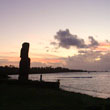 Hanga Roa:
Hanga Roa:
Hanga Roa, is the ‘capital’ and the really the only village on the island, with 2 main streets. The town is situated on the southern part of the West coast between the Rano Kau and Maunga Terevaka volcanoes. About 90% of the islands’ population live here, so all your basic necessities are here as well, such as a pharmacy, small hospital, supermarket, as well as some art galleries, tattoo shop, a disco and a museum.
.
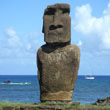 Ahu Tautira:
Ahu Tautira:
The Ahu Tautira, is the spot where you will see your first Moai. The Ahu, or holy platform in the language of Rapa Nui, can be found along the shore of the Caleta, the harbour-bay of Hanga Roa. This Ahu is about 90m long and 2 Moai can be seen looking land inwards.
.
.
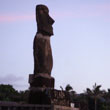 Moai ‘Hotu Matua':
Moai ‘Hotu Matua':
Next to the Ahu Tautira is a smaller Moai on a pedestal looking out over the harbour and the ocean. This Moai was placed on Plaza Hotumatua on a pedestal by the Chilean Navy somewhere around 1940. It is thought that this Moai originally came from the area around the Ahu Tepeu. The Moai is probably facing the wrong way: towards the ocean, as most Moai are looking land inwards. Hotu Matua is thought to be the first king, or Ariki in the Rapa Nui language, who set foot on shore somewhere between the 5th and 12th century AD.
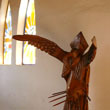 Iglesia Hanga Roa:
Iglesia Hanga Roa:
The catholic church, the Iglesia Hanga Roa, is definitely worth a visit, due to the impressive woodcarvings, mixing Polynesion Rapa Nui culture with Catholism. Mass is on Sunday mornings 09.00, in the Rapa Nui language
Adress: Avenida Te Tu’u Koihu, at the end of Te Pito Te Henua.
.
.
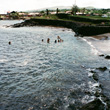 Playa Pea:
Playa Pea:
There are several beaches on Easter Island, but nearest to town is Playa Pea. This little beach is on the south shore of the harbour, Caleta Hanga Roa. It’s a little rocky beach near Ahu Tahai.
Tip: The beaches might not all be postcard material, but they are a nice dip in the ocean and cool down from the beating sun.
.
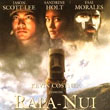 Watch the film Rapa Nui on Rapa Nui:
Watch the film Rapa Nui on Rapa Nui:
4x a week the Manavai Hotel in Hanga Roa shows the movie Rapa Nui, from 1994, at 21.00. The film is based on legends, preceding the years before the discovery by westerners. The story is about an impossible love between members of different tribes, and especially about the yearly ritual to retrieve an egg from a coloured stern , Manu Tara, from the island Motu Nui in order to hand it to Tangata Manu, the bird-man. During the race contestants have to swim shark infested waters, climb the steep cliffs of the Rano Kau in order to end with a complete egg in the village of. The movie is directed by Kevin Reynolds and produced by Kevin Costner, amongst others. Genre: action, adventure & drama. Duration: 1.45 hrs. It’s not a great movie, and it doesn’t tell the truth, about society, as a matter of fact it mixes a few theories and eras together, but it’s quite entertaining, and provides for a good background of what you can find on the island. Definitely worth a visit.
Adress: Av Te Pito Ote Henua 1945, Hanga Roa.
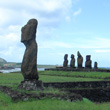 Tahai Complex:
Tahai Complex:
Just north of the Hanga Roa Centre, you can find the Tahai Complex. There are three restored Ahu with Moai: Ahu Vai Uri, Ahu Tahai and Ahu Ko Te Riku. On the north side of these Ahu, you can see the remains of Hare Paenga , a boathouse and jetty. It’s believed that the Tahai complex are amongst the oldest Ahu on Easter Island.
.
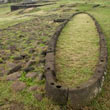 Hare Paenga:
Hare Paenga:
Land inwards, near the Tahai Complex there is the eliptical foundation of a typical boathouse, a Hare Paenga. There are holes made in the stones where the wooden frame of the house could be placed into, which was the base for a roof made of reeds. The door opening is in the direction of the Ahu Vai Uri. More than 3,000 foundations of these boathouses have been found, all over the island. Besides Hare Paenga they are sometimes referred to as Hare Vaka .
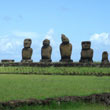 Ahu Vai Uri:
Ahu Vai Uri:
You can see 5 Moai on this Ahu. From left to right: the 1st Moai is largely intact, the next 3 are badly damaged, and the final one on the right, is hardly recognisable as it’s missing its head. Next to the Moai on the left hand side of the Ahu there is space for a 6th Moai. It is not certain of the 6th Moai has been removed or if it has ever been made.
.
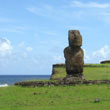 Ahu Tahai:
Ahu Tahai:
The Ahu Tahai complex exists of multiple Ahu with Moai. The Ahu Tahai is an Ahu with a restored Moai standing on its own platform, forming part of the entire Tahai ceremonial comlex. The Moai is partly eroded and just like the Vai Uri Moai does not sport a Pukao, head ornament, nor does he have any eyes.
.
.
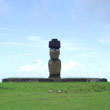 Ahu Ko Te Riku:
Ahu Ko Te Riku:
Ahu Ko Te Riku is als an Ahu with only one Moai, and was restored in 1972 . What makes this particular Moai special is that it carries a Pukao, head ornament. It is also the only Moai on the island with eyes. These restored eyes are made from white coral reef, and the black pupils are from obsidian, volcanic glass. The eerie eyes staring towards you give you a good sense of these statues must have looked like when they were first erected.
.
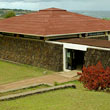 Museo Antropológico P. Sebastián Englert:
Museo Antropológico P. Sebastián Englert:
In the anthropological museum you can see the evidence that the Moai had eyes made from coral. The first eye made from coral, found in Anakena can be found here. There are some interesting utilities that the local inhabitants used throughout the ages to be found here, such as replicas of the Rongorongo tablets (the original Rapap Nui scriptures which to date still don’t have translation), weapons, and fish hooks. Also, there are some drawings of different hutts and houses of the Orongo village. The museum is closed on Mondays, and open on Tuesdays to Fridays from 09:30 to 17:30. And on Saturdays and Sundays from 09:30 to 12:30.
Link: Antropological Museum (ES)
Adress: Just passed the Tahai Complex.
.
Rapa Nui Hanga Roa weergeven op een grotere kaart

